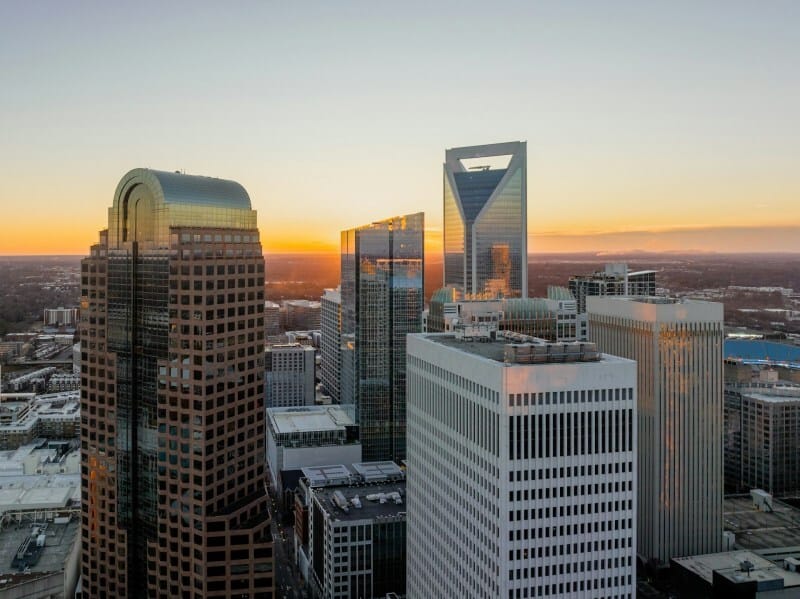Charlotte, North Carolina, is a city that has undergone a remarkable transformation over the last few decades. Its skyline, once dominated by a few tall structures, now features a dynamic and ever-evolving array of modern architectural marvels. This transformation reflects the city’s growth as a financial hub, a center of innovation, and a beacon of southern architectural style.
From sleek skyscrapers to innovative designs that push the boundaries of engineering, Charlotte’s architectural landscape is nothing short of spectacular. This article delves into the city’s modern skyline, exploring its iconic buildings, key architectural trends, and what sets Charlotte apart as a leader in contemporary design.

A Symbol of Progress
Its skyline serves as a symbol of the city’s rapid economic and cultural development. The transformation of the city from a banking center to a diverse metropolis is evident in its architectural landscape. The city’s skyline, which once had a more modest appearance, has now been reshaped by a series of modern skyscrapers that combine function with striking design. The shift from minimalistic structures to more complex, contemporary styles began in the 1990s and has accelerated in the 21st century. Its skyline has evolved to reflect the city’s financial prominence and cultural aspirations, becoming an iconic silhouette.

The Bank of America Corporate Center
The Bank of America Corporate Center is one of the most recognizable landmarks. Standing tall at 871 feet, this 60-story building is the tallest in the city and a major symbol of Charlotte’s growing influence in the financial world. Designed by architect Kevin Roche, the building’s neo-gothic architectural style incorporates elements that evoke both modernity and tradition, making it a timeless icon of the city.
The building is a testament to the city’s prominence as a banking center, housing the headquarters of Bank of America. With its spire reaching high into the sky, it remains the cornerstone of the city’s skyline, dominating the cityscape.

The NASCAR Hall of Fame: Where Innovation Meets Tribute
The NASCAR Hall of Fame is an example of Charlotte’s commitment to blending cultural significance with architectural innovation. Opened in 2010, this striking building was designed by the architectural firm Pei Cobb Freed & Partners. Its angular, dynamic exterior is a perfect metaphor for the excitement and speed of motorsport, making it a fitting tribute to the NASCAR legacy. The design incorporates large glass facades and a spiraling, open-concept layout that invites visitors into the world of racing. Beyond its visual appeal, the building serves as a space to celebrate and honor the history of NASCAR, offering a unique intersection of sports, culture, and architecture.
Image via Charlotte Convention Center.
A Hub for Events and Conferences
Opened in 1995, the Charlotte Convention Center stands as one of the city’s most important event venues. With a design that prioritizes both functionality and modern aesthetics, the Convention Center has become a major hub for business and cultural events in the region. Its sleek, angular lines and expansive glass walls make the building an example of how form and function can coexist harmoniously. The Convention Center’s design was influenced by the city’s desire to promote its status as a major player in business and tourism. It is also a key part of the city’s urban revitalization, helping to draw thousands of visitors every year.

A Growing Trend in the Skyline
In recent years, the growing popularity of North Carolina sportsbooks has contributed to Charlotte’s architectural evolution. These venues, blending gaming and hospitality, often feature sleek, modern designs that complement the city’s contemporary skyline. The integration of these sportsbooks into Charlotte’s urban fabric reflects the city’s embrace of emerging industries and its commitment to providing entertainment options for residents and visitors alike. Whether located in high-rise buildings or part of mixed-use complexes, these spaces highlight how Charlotte is staying ahead of trends while enhancing its status as a destination for entertainment and innovation.

The Fourth Ward District: Blending Historic Charm with Modernity
The Fourth Ward District offers a fascinating blend of historic homes and modern high-rise apartments, showing the city’s ability to balance preservation with innovation. This area, known for its Victorian-style homes, is now home to contemporary buildings that incorporate modern materials while respecting the area’s historical context. This district highlights how architectural landscape is embracing change while honoring its past. The Fourth Ward District has become an ideal example of how modern designs can coexist with older buildings, creating an eclectic and dynamic urban environment.

The Bank of America Stadium: A Modern Sports Arena
Home to the NFL’s Carolina Panthers, the Bank of America Stadium is a premier sports venue that plays a key role in its modern skyline. Opened in 1996, the stadium was designed to be a modern, fan-friendly venue with an emphasis on comfort and visibility. Recent renovations have focused on enhancing the fan experience, with the addition of new suites, luxury seating, and state-of-the-art technology. The stadium’s design blends traditional stadium features with modern upgrades, creating an iconic and visually appealing structure that stands as a key part of the skyline.

The Duke Energy Center: Charlotte’s Sustainable Skyscraper
The Duke Energy Center is another example of the city’s commitment to sustainable architecture. Completed in 2010, this 40-story skyscraper features a sleek, modern design with a focus on energy efficiency and sustainability. The building incorporates a range of green features, such as energy-efficient lighting, water-saving systems, and green roofs.
These eco-friendly elements not only make the Duke Energy Center an environmentally conscious building but also help it blend seamlessly into the city’s broader efforts to become a more sustainable urban center. As one of the city’s tallest buildings, it stands as a model of how modern skyscrapers can be designed with both style and sustainability in mind.
From Traditional to Cutting-Edge
Charlotte’s urban design has evolved significantly over the past few decades. Once dominated by low-rise buildings, the city now boasts a modern skyline that reflects the region’s growing population and expanding economic base. The shift towards vertical living has played a crucial role in this transformation, with high-rise apartments and condominiums becoming increasingly popular. These buildings are designed to accommodate the city’s growing population while maintaining a focus on sustainable development and modern living standards. As it continues to grow, its urban design will evolve further, incorporating even more innovative features to meet the needs of its residents.
Its modern skyline is a testament to the city’s growth and ambition. With an array of architectural marvels that blend functionality with innovation, the city has positioned itself as a leader in contemporary design. From the iconic Bank of America Corporate Center to the sustainable Duke Energy Center, the skyline is a mix of past achievements and future possibilities. As the city develops, its architectural landscape will evolve, offering new opportunities for residents and visitors to experience the best of modern urban design.
The post Charlotte’s Modern Skyline and Architectural Marvels appeared first on Moss and Fog.
